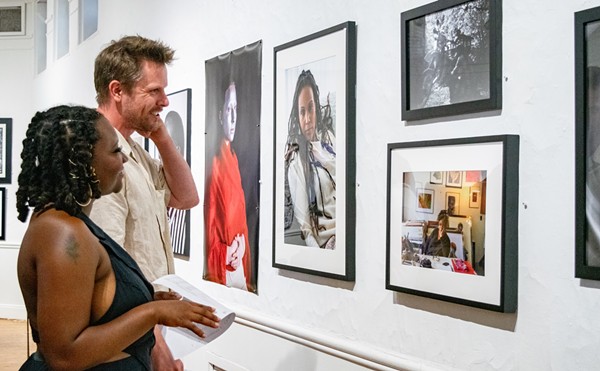"Peace on Earth and Good Will Toward Men” — is this age-old credo one to live by or just an ironic wisecrack in these lethal times? With the year-end holidays upon us, how about choosing generosity and compassion — for neighbors and strangers alike — over fear and loathing? And to get us in the mood, let’s jump in the old gas-guzzler for a turn around this awesomely multicultural metropolis of ours, as we take in spiritual artworks from around the world and across the centuries that express a longing for something other than hatred and greed.
First stop, of course, is the Detroit Institute of Arts, home to an array of compelling objects from as many cultures as we can think of. The DIA’s Flemish collection on the third floor of the South Wing (gallery S332) contains paintings that represent Judeo-Christian biblical scenes and themes, executed with breathtaking color and technique. One of the most fascinating of these is The Annunciation (1490, oil on oak panel), attributed to Gerard David. In this fairly small work, we see the archangel Gabriel hovering in the air of Mary’s room, flanked by symbols of the Holy Spirit (the bird), Mary’s purity (the potted lily) and knowledge (the book bag on the floor). Gabriel is giving Mary the news of her unique role in history. Although the image contains allusions to both the Old and New Testaments (such as the tiny painting of Moses and the Burning Bush on the back wall), it’s the glowing light that David suffuses throughout this work that rivets us and keeps us noticing more and more details — such as the apple resting on the cabinet below Gabriel’s wing, a reference to the original loss of Paradise and Christ’s role in humanity’s recovery of it.
It’s hard to tear ourselves away from the Flemish pieces, but next we walk the length of the museum to the ground floor of the North Wing, home of the Islamic art collection. There the glass cases contain exquisite pages from the Qu’uran, written out in flowing calligraphy, but without images of the material world. Sacred Islamic texts don’t include renderings of people or objects. So the focus of a ceramic Molded Frieze Tile (late 13th century, Persian), hanging on the east wall, is on Arabic written characters — blue and stunning — that translate into “The Sublime, The Beautiful.” There’s a brilliant sheen to the in-glaze-painted and over-glaze luster-painted surface, a technique that was passed down in secret for four or five centuries. But in this piece from central Iran (while it was under the rule of the Ilkhanid Mongol Dynasty), the rules have been stretched to allow representations of birds and a hare in the background. The tile, which was part of the decoration of the interior of a holy man’s shrine, combines the animal figures with more abstract motifs to express a yearning for the divine, an absolute spiritual state that cannot be expressed by humans except in thought.
An hour later, we’re heading out I-94 to Ann Arbor, where the University of Michigan Museum of Art houses a major collection of Asian art, among its other fine holdings. At the center of the second-floor balcony, as if guarding the museum precincts from harm, sits a stone sculpture of Varahi (11th century, Indian, Chola period), the female counterpart of Varaha, an incarnation of the god Vishnu. This Hindu goddess has the face of a sow, but her torso is a radical idealization of femininity — full, rounded breasts and hips; an exceptionally narrow waist; long, slender legs — all of which clearly distinguishes her from the temporal world. Varahi is one of the Saptamatrikas, or Seven Mothers, worshiped in southern India until the end of the 11th century. This feminine deity is a manifestation of Devi, the great goddess who sustains and protects all of creation, who heals by unifying opposites. UMMA’s Varahi originally must have had four arms, but two of them are missing, as is the hand on one of the remaining arms. Her gestures (called mudras) include the “fear not” sign and another that bestows blessings. Despite the centuries separating her from us, she’s a beautifully calming presence.
At the opposite end of the second floor, UMMA has installed a drop-dead inspirational show called “Masterworks of Chinese Painting: In Pursuit of Mists and Clouds,” that will be on view through Jan. 5, 2003 (free of charge). Among the 60 or so works from the James Cahill family collection spanning more than eight centuries are landscapes, nature studies and portraits that immerse us in a long history of meditative art. The visionary methodologies of Taoism, Confucianism and Buddhism mingle in these works, opening a time capsule for Westerners into a world of silence and peaceful realization. Wang Chen’s Monk Conjuring Up a Pagoda (1914, ink and color on paper) helps us understand the notion that the world we live in is the world of our own mind. Here, a monk looks into thin air to see a pagoda within billows of what appears to be incense. Is the tower in the sky really there or is it a symbol of no-mind, that combination of Buddhist practice’s goal and the means to its attainment? Wang Chen was a devout Buddhist, a revolutionary and a businessman in turbulent early 20th-century China, but his dharma heart reaches out to us across the years.
Then a jaunt up to Bloomfield Hills — another hour on the expressways — brings us to our last, but not least, destination: the Cranbrook Art Museum. Since it’s devoted to modern art — much of which is abstract, analytical and disruptively feminine, marvelous and tough — we don’t usually associate this edgy place with spirituality. But American abstract expressionism raised lots of deep, philosophical questions, and the museum’s recent acquisition of the Dr. John and Rose M. Shuey Collection brought it a number of masterpieces of the genre. Among them is Robert Motherwell’s Red Open #3 (1973, acrylic on canvas), a two-toned evocation of the eternal. If you listen to visitors standing in front of abstract works in any museum in the world, you’ll hear them trying to find renderings of the real in paintings that deliberately avoid such references. Motherwell’s piece has been seen as a window or a door into the ineffable, but it also suggests a force or phenomenon “coming down,” the way an elevator does — something mysterious and white from an “unknown” above the red picture plane. Is this indecisiveness a form of the spiritual? Is wondering as important to the spiritual mind as devotion? It could happen.
Where the art is:
Cranbrook Art Museum
39221 N. Woodward Ave., Bloomfield Hills
877-462-7262
Detroit Institute of Arts
5200 Woodward Ave., Detroit
313-833-7900
University of Michigan Museum of Art
525 South State St., Ann Arbor
734-764-0395





